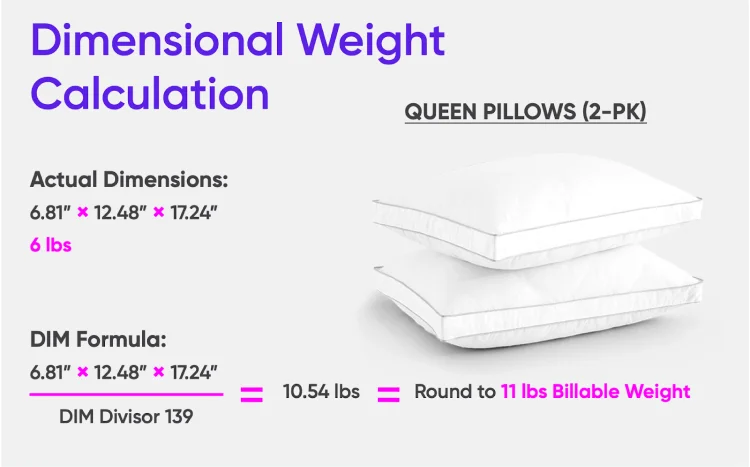There are a number of seller fees affected by Amazon dimensional weight (DIM) pricing of products. It already existed as an aspect of some fees before the 2023 increases, but as of February 16, it now affects apparel. That new inclusion comes on top of the increased granularity and effect DIM pricing has on a seller’s overall fee calculation.
We discuss this in more detail inside our Attack of the Fee Stack white paper, which illustrates every aspect of the 2023 fee increases with in-depth analysis and case studies.
This free educational paper was put together by our team of experts and contains explanations, tips, and strategies to help your business stay profitable during the fee hikes this year, and any that may come in future.
While it may not be a “fee” as such, DIM weight pricing is all but ubiquitous in the way it can affect your costs, and poses a true threat to your profits as an Amazon FBA seller.
To know how to fight back, though, you must first understand what is dimensional weight and how it might affect your business.
What Is Amazon’s Dimensional Weight Pricing (DIM)?

DIM weight pricing could – and SHOULD – change the way you package your products.
Dimensional weight, also known as volumetric weight, is a pricing method used by shipping carriers like Amazon to account for the space a package takes up in relation to its actual weight.
This method is particularly relevant when shipping lightweight, bulky items that may take up a significant amount of space in a carrier’s vehicle, even though they don’t weigh much.
The basic idea behind Amazon dimensional weight pricing is to ensure that shipping costs accurately reflect the amount of space a package occupies in a carrier’s transportation network. This helps carriers optimize their cargo space and improve efficiency.
How to Calculate Dimensional Weight?
The dimensional weight formula for calculating DIM weight varies between carriers, but a common approach is:
Formula Breakdown
Providing a breakdown can help you understand how the DIM weight formula works. This comprehension is essential for making informed decisions or optimizing packaging design processes.
Package Dimensions
Amazon typically measures package dimensions using three main parameters: length, width, and height. These dimensions are used to determine the size and volume of a package, which is crucial for calculating shipping costs, storage fees, and ensuring that items can be efficiently packed and transported.
Amazon measures these dimensions in inches or centimeters, depending on the unit of measurement selected. The measurements are typically taken at the widest points of the package, including any protruding elements such as handles or wheels. It’s important for you to provide accurate package dimensions when listing products on Amazon, as incorrect information can lead to miscalculated shipping fees and potential issues with fulfillment.
Keep in mind that Amazon may use these dimensions to categorize products and apply fees based on the size tier, which can impact shipping costs and storage fees. It’s crucial for sellers to adhere to Amazon’s packaging and dimension guidelines to ensure accurate and efficient processing of their units.
DIM Divisor
The dimensional weight divisor, often referred to as the “DIM divisor” or “dimensional factor,” is a constant used by shipping carriers in the dimensional weight pricing formula. It is a crucial component in determining the dimensional weight of a package.
The DIM divisor represents the number of cubic inches that are considered equivalent to one pound in the dimensional weight calculation. It is essentially a factor that helps convert the volume of a package into a weight equivalent for shipping cost calculations. The larger the DIM divisor, the less impact the package’s size has on the dimensional weight.
In Amazon’s case, the DIM divisor is 139 in/lb, which is most common within the US shipping industry standard. For packages shipped across the UK/Europe, the divisor for calculating DIM weight is 5,000 cm³/kg.
So, if Amazon uses a DIM divisor of 139 in/lb, it means that for every 139 cubic inches of space a package occupies, the dimensional weight is increased by one pound. In this case, a package with dimensions that result in a dimensional weight of 2 pounds or less based on the formula may be charged at its actual weight. However, if the dimensional weight exceeds 2 pounds, the shipping cost is calculated based on the higher dimensional weight. More on that later.
The impact of the DIM divisor on shipping costs is significant, especially for large but lightweight packages. A higher DIM divisor makes it more likely that the dimensional weight will be higher than the actual weight, leading to higher shipping costs. Carriers may adjust their DIM divisor based on factors such as the available cargo space in their vehicles, fuel efficiency, and the overall efficiency of their transportation network.
Therefore, sellers should be aware of the DIM divisor used by the carrier they are using, as it directly affects the cost of shipping, particularly for items that are lightweight but occupy a considerable amount of space.
Here’s how the dimensional weight pricing method typically works:
- Actual Weight vs. Dimensional Weight: The carrier calculates both the actual weight (in pounds) and the dimensional weight of the package.
- Comparison: The carrier compares the actual weight and the dimensional weight, and the higher of the two is used to determine shipping costs.
- Cost Calculation: Shipping costs are then calculated based on the higher of the actual weight or dimensional weight, considering the shipping service, destination, and other relevant factors.
Simply put, if a package is large but relatively light, it would have a higher DIM weight than actual weight, so the DIM weight would be used as the billable weight.
This method encourages sellers to be mindful of the size of their packages, as larger, lightweight items can incur higher shipping costs due to their impact on the carrier’s transportation efficiency. Many major shipping carriers, including Amazon, UPS, FedEx, and DHL, use dimensional weight pricing for certain services.
Consider using an Amazon dimensional weight calculator to accurately determine your shipping costs based on package dimensions. It facilitates cost-effective decision-making by comparing actual weight with dimensional weight, enabling optimization for lower-cost size tiers on Amazon. The calculator aids in budget planning, assists in selecting the most economical shipping solutions, and helps prevent surprises related to higher-than-expected shipping costs. By optimizing packaging and understanding the impact of dimensional weight on profitability, you can make informed decisions and streamline your logistics processes, ultimately saving time and resources.
How Is Amazon DIM Weight Pricing Used?
In 2022, Amazon introduced new DIM weight pricing, which applied to its entire catalog, excluding apparel. It was used to calculate fulfillment fees for large standard-size SKUs, as well as small, medium, and large oversize SKUs, and applied to multi-channel fulfillment (MCF) and Small & Light.
Along with large standard apparel no longer being exempt from DIM weight pricing as of 16th February 2023, it has begun to saturate the way almost every other fee is calculated. This includes FBA fulfillment fees, as well as others like removals, Multi-Channel Fulfillment (MCF), and even Remote Fulfillment in North America (NARF).
Being charged fees according to DIM weight as opposed to actual weight can seem unfair when it causes a sudden cost increase, which is why it is important to consider both the weight and volume of SKUs and maintain the most cost-efficient balance.
2 Key Issues Sellers Face Due to Amazon DIM Weight Pricing
With this understanding of DIM weight pricing, let’s take a look at how it can affect costs and profitability in 2023 and beyond.
1. Increased Shipping Costs
Shipping companies have used DIM weight for several years. A higher DIM weight than actual weight will cause an increased shipping cost, no matter who ships a package.
The logic behind DIM weight pricing is that a package is charged based on the volume it takes up on a plane, truck, or boat, as opposed to the weight.
Think of it as a ton of feathers vs. a ton of steel: they both weigh the same, but because feathers are less dense than steel, they could take up more room and resources.
To see this in practice, here is the effect of a DIM weight calculation on a two-pack of queen-sized pillows, as seen in our free white paper.

You can see other examples, as well as a layout of the entire Amazon fee structure, and how DIM weight affects it, in Amazon’s full report on its 2023 fee changes in Seller Central.
Being charged shipping by volumetric weight rather than actual weight can increase fees and shipping costs on large but light SKUs such as lampshades, pillows, etc. These increased costs can cut into the profits of each SKU unless prices are raised or a way is found to lower costs.
2. Unexpected Fees
There are a few places that DIM weight pricing is now popping up that you might not expect:
- Hidden inside multi-channel fulfillment (MCF) fees. Now DIM weight pricing may be used to calculate the shipping cost for SKUs that are fulfilled by Amazon for non-Amazon sales.
- DIM weight for packaged items was added to the calculation of removals and disposals in 2022, and fees are set to increase in 2023.
While the DIM weight itself is not used to calculate some of the new and increased storage fees, they are affected by the volume of stored inventory.
Since DIM weight and volume are closely connected, how long and where you store your product is definitely something to keep in mind, especially after the new storage utilization surcharge Amazon is introducing in 2023, and the way it is changing its FBA aged inventory surcharges.
6 Viable Workarounds to Offset Higher Shipping Fees

1. Optimize Packaging Size
It might seem obvious, but reducing the package size can reduce the shipping cost. Working with suppliers or manufacturers to reduce the size of packaging will make a big difference to reducing affected costs.
Simple steps like vacuum packing soft products like pillows, padded jackets, or plush toys can greatly reduce their volume. Products that require customer assembly such as electronics or furniture can be rearranged within packaging to reduce their DIM weight.
Audit your products for their DIM weights and speak to suppliers/manufacturers to work together on bringing the billable weight down.
Depending on your current inventory and sell through rate, it might take a while for this strategy to show results, but optimizing the packaging of your products will only be beneficial in the long run.
- Smaller packaging will help you fit more per carton or pallet, helping reduce overall shipping costs.
- Less packaging will reduce materials and costs required.
- More carefully packaged products will reduce in-transit damage and increase customer satisfaction.
Maximize savings by using SoStocked’s FBA Size Tier Optimizer tool to align your Amazon products and packaging with the most cost-effective shipping weight tiers. Simply input your unit preferences and product details to identify opportunities for size reduction and qualify for lower FBA size tiers. This can lead to substantial savings on both storage and shipping fees. Afterward, explore additional savings with our complimentary Amazon Master Carton Calculator tool.
2. Run the Numbers
Increased shipping costs due to DIM weight pricing could substantially impact profit margins, particularly for low-priced items.
This scenario may create challenges in maintaining competitiveness, as raising your selling price becomes necessary to cover these additional fees. However, this adjustment could potentially deter some customers from making purchases.
To maintain cost efficiency, regularly review your Amazon fees and conduct profit calculations to ensure ongoing profitability for your products.
3. Minimize or Avoid Inventory-Related Problems
Two of the biggest inventory challenges that can significantly impact sellers are stockouts and overstocking.
Maintaining excess inventory can lead to substantial costs at FBA, including warehouse expenses, additional storage fees, opportunity costs, insurance, and potential shrinkage losses. The longer excess inventory remains unsold in a warehouse, the higher these holding costs become.
Stocking out presents its own set of issues, such as lost rankings, income, and the need for express air shipping. Hidden costs include dissatisfied customers, productivity loss, and expenses incurred when managing backorders.
While listing a back-ordered product on Amazon is an option, it comes with drawbacks. Potential customers may be deterred by longer estimated ship dates, impacting conversion rates. Moreover, expediting production and shipping to meet demand can incur additional expenses. Failing to ship a back-ordered item on time may result in negative feedback, affecting your seller’s account health.
These inventory challenges often arise from a lack of effective inventory monitoring and demand forecasting. This is where a robust inventory management system like SoStocked proves invaluable.
SoStocked streamlines the restocking process, purchase order management, and supplier lead times. Automating these processes not only enhances efficiency but also mitigates stockouts and excess inventory issues.
4. Negotiate with Carriers
Nobody ever pays less without having to ask! Negotiating or renegotiating with your carriers is a good place to reduce costs.
It can be awkward, especially in light of the supply chain troubles and increased charges for fuel in the last few years, but it’s a great step to reduce costs. Once you get through that awkwardness, it might even result in a way to foster a stronger relationship with your suppliers and carriers.
5. Use Third-Party Shipping Solutions
Amazon prides itself on fast and cheap shipping, so much so that even in the 2023 fee increase announcement, it maintained that:
“Amazon’s fulfillment fees will remain an average of 30% less expensive than standard-shipping methods offered by other major third-party logistics providers, and an average of 70% less expensive than comparable two-day shipping alternatives.” But that doesn’t necessarily mean it will always be cheaper. Other carriers use a different DIM weight divisor than Amazon’s 139. Yes, it is the most common with FedEx and DHL also using 139, but USPS uses 166, as does UPS for its retail rate.
Auditing the costs of shipping your products yourself vs. the increased fees through FBA could help you see where you can cut costs.
DIM weight pricing is gaining traction within Amazon’s fee calculations. Being aware of your catalog’s DIM weights, as well as which fees will be affected by them, will help you face them without worry of extra hidden charges.
6. Hire a Reimbursement Service Provider
Recover the funds Amazon owes you by enlisting the expertise of Amazon reimbursement services providers. A rejected reimbursement request from Amazon doesn’t signal the end of the road.
Consider partnering with a service provider well-versed in the intricacies of the process, such as Seller Investigators (SI). Unlike standard Amazon software suites with automated reimbursement management, these specialists focus on maximizing your recovery. SI excels at securing approvals for previously rejected requests, offering a nuanced understanding of Amazon’s reimbursement program.
For those who have faced approval challenges, a service with insight into Amazon’s reimbursement intricacies is essential. Act promptly, as you only have an 18-month window to file reimbursement claims. Submissions beyond this timeframe are ineligible for reimbursement.
Understanding and Overcoming the Challenges of Amazon DIM Weight Pricing
In conclusion, the impact of Amazon dimensional weight pricing on FBA sellers is a major and evolving challenge, with the recent extension to apparel fees adding to its complexity. The recent fee increases have heightened the overall effect of DIM pricing on sellers’ fee calculations.
For a comprehensive understanding of these changes and effective strategies to navigate them, our team of experts has compiled valuable insights in our Attack of the Fee Stack white paper.
To safeguard your business from the repercussions of these fee hikes and potential future increases, it is crucial to grasp the intricacies of dimensional weight and its impact on your profitability as an Amazon FBA seller. Stay informed, adapt, and implement the strategies outlined in our white paper to ensure the continued success of your business on the Amazon platform.
If you don’t want to get caught with extra fees you weren’t expecting, check out the premiere Carbon6 inventory management tool, SoStocked, and avoid extra fees, overstocks, stockouts and much more.
You can also offset losses with some of our other solutions, like having Seller Investigators hunt down and return money Amazon owes you in reimbursements. You can even try selling on Walmart.com as an alternate platform — just make sure you simplify your success there with WallySmarter.








